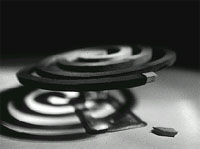Counteractive
 coils, mats, oils, creams and other forms of mosquito repellents may help keep the gnats away, but they do not come without a price. Studies conducted by the Malaria Research Centre (mrc), New Delhi, reveal that they can cause several ailments, including bronchitis, respiratory problems, eye irritation and nausea. Very little is known about the long-term health implications of these products and in-depth scientific evaluation of these products has not been conducted. But from the little research that is available there is enough evidence to cause sleepless nights.
coils, mats, oils, creams and other forms of mosquito repellents may help keep the gnats away, but they do not come without a price. Studies conducted by the Malaria Research Centre (mrc), New Delhi, reveal that they can cause several ailments, including bronchitis, respiratory problems, eye irritation and nausea. Very little is known about the long-term health implications of these products and in-depth scientific evaluation of these products has not been conducted. But from the little research that is available there is enough evidence to cause sleepless nights.
For the average Indian, it is a choice between the devil and the deep blue sea. If repellents have adverse health effects, then what is the answer to mosquitoes and malaria? India is home to 255 species of mosquitoes that are involved in the spread of infectious diseases such as malaria, dengue, filariasis and Japanese encephalitis (pig flu). The National Malaria Eradication Programme (nmep), Delhi, reported that two million people suffer from malaria in India each year.
In his paper titled Health Hazards of Mosquito Coils and Mats , V P Sharma, former director of mrc , says that Rs 5,000 crore of worth mosquito coils and mats are sold annually in the Indian market at present, and the amount is increasing all the time. "Of the 12,500 million pieces of mosquito coils and mats sold worldwide in 1998, India and Southeast Asian countries account for 60 per cent,' Sharma points out.
"Earlier, mosquito coils had dichloro-diphenyl trichloroethane (ddt) and other organochlorine compounds,' says Sharma, "but these products were not effective enough in warding off mosquitoes.' At present, the basic chemicals used in repellents are pyrethroids, insecticides obtained from flower extracts. But the pyrethroids used in the repellents are synthetic, and are obtained from the insecticide allethrin. The synthetic pyrethroids vaporise when they are heated up to temperatures of 400
Related Content
- Scaling up ecosystem restoration finance: a stocktake report
- The cost of delay: why finance to address loss and damage must be agreed at COP27
- COVID19, the environment, and food systems: contain, cope and rebuild better
- Tracking clean energy innovation: A framework for using indicators to inform policy
- Policy responses to COVID-19: Addressing the impact of the pandemic on tourism in Asia-Pacific small island developing States
- Impact of fiscal policy on poverty and inequality in Uganda: fiscal incidence analysis using the UNHS 2016/17
